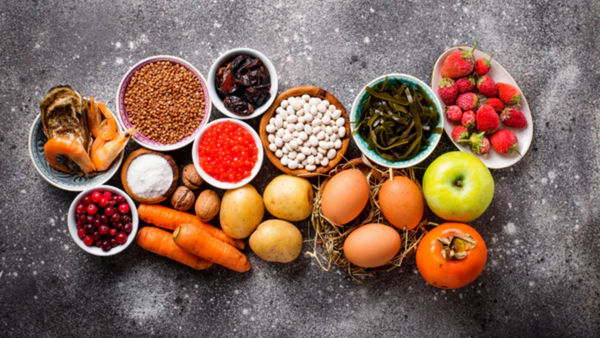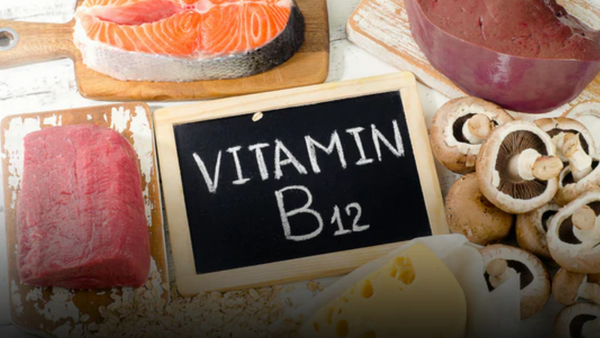Trace elements are minerals, but are only needed in small amounts, i.e. in trace amounts. Since our body cannot produce them itself, they are essential. This means that we have to consume them through food.
Just because they are needed in small amounts does not make them less important than other essential nutrients.
Here you will find an overview of the 9 essential trace elements: what the body needs them for, how much you need daily and how you can meet your needs.
IT'S WORTH READING!
AT THE END OF THE ARTICLE WE WOULD LIKE TO GIVE YOU A LITTLE JOY WITH A VOUCHER!
Chrome
Chromium has important functions in carbohydrate metabolism. It helps regulate blood sugar and is involved in the storage of carbohydrates, fat and protein.
A chromium deficiency can lead to coordination problems, weight loss and problems with blood sugar regulation. However, chromium deficiency is very rare in western industrialized countries. [1]

Chrome requirements
According to the German Nutrition Society (DGE), the daily requirement of chromium is 30 – 100 µg. [2]
Foods containing chromium
Chromium is found in many foods such as meat, grains, fruits, vegetables and nuts. Chromium content also depends heavily on processing. When foods come into contact with stainless steel, their chromium content increases. [3]
Cobalt
Cobalt is a component of vitamin B12 (cobalamin). [4] Vitamin B12 is important for fat and protein metabolism, the regeneration of nerve cells and for blood formation. You can find out more about this in our detailed article on vitamin B12 .
Cobalt requirements
The daily requirement of cobalt is 5 - 8 µg. [5]
Foods containing cobalt
Cobalt is found in foods that also contain vitamin B12, i.e. in all animal foods. Here you can find out which are the best sources of vitamin B12 .
Iron
Iron is especially important for the transport of oxygen in the blood. Iron is also involved in many biochemical reactions. [6]
Iron deficiency leads to impaired formation of red blood cells. Pregnant women and menstruating women are at increased risk of iron deficiency. Typical symptoms are: [7]
- paleness
- Difficulty concentrating
- easy fatigue
- Performance loss
- Loss of appetite
- Dry skin
- increased susceptibility to infection
Iron requirements
According to the DGE, the daily requirement of iron is 10 - 15 mg. [8]
Iron-containing foods
Iron is found in many plant and animal foods. However, animal iron can be better absorbed and utilized. The absorption of plant iron can be improved if it is combined with vitamin C.
The following foods are the best sources of iron: [9]
- Cocoa (13.9 mg/100 g)
- Nuts and seeds (e.g. hemp seeds with 7.95 mg/100 g)
- Liver (7.4 mg/100 g)
- Meat (e.g. beef with 5.46 mg/100 g)
- Seafood (e.g. oysters with 5.78 mg/100g)

Iodine
As a component of thyroid hormones, iodine is important for the function of the thyroid gland. But all other organs also need iodine. It has important functions in energy metabolism and cell growth. [10]
Iodine deficiency is one of the most common nutritional deficiencies . The soil in Germany is poor in iodine, which is why a deficiency is very common here too. Iodized table salt does help to cover the need, but is usually not enough on its own.
In our article about iodine you will learn more about why this trace element is so important.
An iodine deficiency manifests itself through [11]
- Goiter formation
- Tiredness and exhaustion
- rough, dry skin
- Obesity
- slight chills
- Hair loss
Iodine requirement
According to the DGE, the daily requirement of iodine is approximately 200 µg. [12]
Foods containing iodine
Iodine is found in the following foods: [13]
- iodized table salt (5070 µg/100 g)
- Algae (e.g. dried nori seaweed with 2320 µg/100 g)
- Eggs (49.2 µg/100 g)
- Milk (34.3 µg/100 g)
- Fish (e.g. salmon with 26.2 µg/100 g)
- Seafood (e.g. shrimps with 14.7 µg/100 g)
- Poultry (e.g. turkey with 2.1 µg/100 g)
- Legumes (e.g. kidney beans with 1.1 µg/100 g)
- Vegetables (e.g. carrots with 0.5 µg/100 g)
Copper
Copper is a component of many proteins. It has important functions in carbohydrate, protein and fat metabolism. The immune system also needs copper and it is important for iron metabolism. [14]
A copper deficiency is rare in Germany. It manifests itself in tiredness and exhaustion, bone loss, memory and concentration problems, paleness and premature graying.
In our article on copper we take a closer look at this trace element.
Copper requirements
According to the DGE, the daily requirement of copper is 1.0 – 1.5 mg. [15]
Foods containing copper
Copper is found in the following foods: [16]
- Liver (e.g. beef liver with 14.59 mg/100 g)
- Oysters (5.71 mg/100 g)
- dried shiitake mushrooms (5.17 mg/100 g)
- Nuts and seeds (e.g. sesame with 4.08 mg/100 g)
- Cocoa (3.79 mg/100 g)
- Seafood (e.g. lobster with 1.55 mg/100 g)
Manganese
Manganese is important for connective tissue. It also activates numerous enzymes and is needed for the synthesis of proteins. Manganese deficiency is rare. It manifests itself in bone problems, reduced fertility and disorders in carbohydrate and fat metabolism. [17]
Manganese requirement
According to the DGE, the daily requirement of manganese is 2 - 5 mg. [18]
Manganese-containing foods
Manganese is found in the following foods: [19]
- Spices (e.g. cardamom with 28 mg/100g)
- Nuts (e.g. hazelnuts with 13 mg/100g)
- Garlic (2 mg/100 g)
- Fruit (e.g. pineapple with 2 mg/100 g)
- Legumes (e.g. lima beans with 2 mg/100 g)
- Algae (e.g. Wakame algae with 1 mg/100g)
- Oysters (1 mg/100g)
Molybdenum
Molybdenum is important for the formation of uric acid and is a component of many enzymes. A deficiency in molybdenum is very rare. It manifests itself in rapid heartbeat, mental problems and headaches. [20]
Molybdenum requirements
According to the DGE, the daily requirement of molybdenum is 50 – 100 µg. [21]
Foods containing molybdenum
Molybdenum is found in the following foods: [22]
- Legumes (e.g. lima beans with 870 µg/100 g)
- Eggs (9 µg/100 g)
- Fruit (e.g. pineapple with 9 µg/100 g)
- green leafy vegetables (e.g. spinach with 7 µg/100 g)
- Tomatoes (5 µg/100 g)
Selenium
Selenium has important functions in the metabolism of thyroid hormones. It also protects against oxidative stress and is required for DNA synthesis. [23]
In our detailed article about selenium you will learn more about why selenium is so important for the body.
Germany is a selenium deficiency area and therefore selenium deficiency is widespread. A selenium deficiency manifests itself in
- reduced fertility
- exhaustion
- Concentration problems
- increased susceptibility to infection
Selenium requirement
According to the DGE, the daily requirement of selenium is 60 – 70 µg. [24]
Foods containing selenium
The following foods are the best sources of selenium: [25]
- Brazil nuts
- Oysters
- liver
- Fish
- Seeds
- seafood
- Meat

zinc
Zinc is essential for the functioning of the immune system. It also plays an important role in wound healing and is important for the skin. [26] 32% of men and 21% of women do not get enough zinc from their diet. [27] Therefore, zinc deficiency is not uncommon. It manifests itself in the following symptoms:
- poor wound healing
- reduced sense of taste and smell
- Diarrhea
- Loss of appetite
In our article about zinc you will learn more about what functions it has in the body.
Zinc requirement
According to the DGE, the daily requirement for zinc is 10 – 16 mg. The requirement depends mainly on the consumption of foods containing phytic acid (legumes and grains). This is because phytic acid binds zinc and thus hinders its absorption. [28]
Foods containing zinc
The following foods are the best sources of zinc: [29]
- Oysters (45.1 mg/100 g)
- Liver (e.g. veal liver with 11.2 mg/100 g)
- Nuts and seeds (e.g. hemp seeds with 9.9 mg/100 g)
- Cocoa (9.63 mg/100 g)
- Meat (such as beef with 8.78 mg/100 g)
Conclusion: Important trace elements are often neglected
Trace elements are essential minerals that our body only needs in small amounts. Nevertheless, they are of great importance to us. Trace elements include chromium, cobalt, iron, iodine, copper, manganese, molybdenum, selenium and zinc. Of these, iron, iodine, selenium and zinc are often neglected in the diet.
AS PROMISED, YOU WILL RECEIVE A 10% VOUCHER ON OUR VITAMIN B12 , Zinc & Copper , Essential 4-daily and Selenium Tablets .
JUST COPY THE CODE ELEMENTS+V10 AND ENTER IT AT CHECKOUT.
Click here to shop
[1] https://ods.od.nih.gov/factsheets/Chromium-HealthProfessional/
[2] https://www.dge.de/forschung/referenzwerte/kupfer-mangan-chrom-molybdaen/
[3] https://ods.od.nih.gov/factsheets/Chromium-HealthProfessional/
[4] https://pubmed.ncbi.nlm.nih.gov/24470095/
[5] https://www.urmc.rochester.edu/encyclopedia/content.aspx?contenttypeid=19&contentid=cobalt
[6] https://www.ncbi.nlm.nih.gov/pmc/articles/PMC3999603/
[7] https://www.nhs.uk/conditions/iron-deficiency-anaemia/
[8] https://www.dge.de/forschung/referenzwerte/eisen/?L=0
[9] https://nutritiondata.self.com/foods-000119000000000000000-w.html
[10] https://www.ncbi.nlm.nih.gov/pmc/articles/PMC3063534/
[11] https://pubmed.ncbi.nlm.nih.gov/21748117/
[12] https://www.dge.de/forschung/referenzwerte/jod/?L=0
[13] https://www.ars.usda.gov/northeast-area/beltsville-md-bhnrc/beltsville-human-nutrition-research-center/methods-and-application-of-food-composition-laboratory/mafcl -site-pages/iodine/
[14] https://www.ncbi.nlm.nih.gov/books/NBK225407/
[15] https://www.dge.de/forschung/referenzwerte/kupfer-mangan-chrom-molybdaen/?L=0
[16] https://nutritiondata.self.com/foods-000125000000000000000-w.html
[17] https://pubmed.ncbi.nlm.nih.gov/24470093/
[18] https://www.dge.de/forschung/referenzwerte/kupfer-mangan-chrom-molybdaen/
[19] https://nutritiondata.self.com/foods-000126000000000000000-w.html
[20] https://pubmed.ncbi.nlm.nih.gov/8302261/
[21] https://www.dge.de/forschung/referenzwerte/kupfer-mangan-chrom-molybdaen/?L=0
[22] https://pubmed.ncbi.nlm.nih.gov/7369160/
[23] https://www.ncbi.nlm.nih.gov/books/NBK557551/
[24] https://www.dge.de/forschung/referenzwerte/selen/
[25] https://nutritiondata.self.com/foods-000127000000000000000-w.html
[26] https://www.ncbi.nlm.nih.gov/pmc/articles/PMC3724376/
[27] https://www.bmel.de/DE/themen/ernaehrung/gesunde-ernaehrung/nationale-verzehrsstudie-aufnahme.html
[28] https://www.dge.de/forschung/referenzwerte/zink/?L=0
[29] https://nutritiondata.self.com/foods-000124000000000000000.html

















